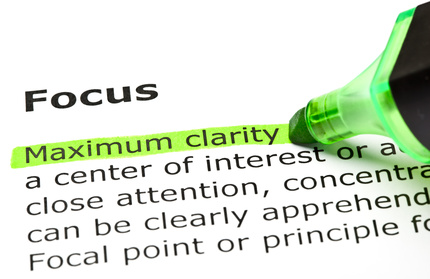4 Principles of Leadership Clarity
Jack, a coaching client, came to our meeting visibly upset. “I don’t know what else to do with this employee,” he lamented. “He’s got a track record of success and incredible potential, but he doesn’t get the job done. Everything I’ve delegated to him comes back unfinished or sub-par.”
 “How does he respond when you discuss this with him?” I asked.
“How does he respond when you discuss this with him?” I asked.
“He says he’s getting mixed messages,” Jack replied. “I tell him to focus on quality and doing things right, Janelle (his VP) tells him to speed up because time is of the essence, his coworker Amy does the same work but has shown him a completely different way of doing it than how he was taught.” A lightbulb seemed to come on for Jack in that moment. “I guess he doesn’t know who to listen to or what matters most.”
This illustrates a common leadership scenario. How many times have you read a company’s (maybe your company’s) mission statement touting what matters most – then seen completely different principles in action?
Ambiguity = Conflict
In many ways, successful leadership comes down to one word: CLARITY. In his bestselling book The Advantage, Patrick Lencioni stresses the importance of clarity above all else; in fact, 3 of his 4 principles are Create Clarity, Overcommunicate Clarity, and Reinforce Clarity. Leadership consultant Cy Wakeman affirms its importance by claiming, “Ambiguity is the source of all conflict.”
 As a leader, you must be crystal-clear about the fundamental principles of your organization. At the core, you need to be able to answer the following 4 questions simply and directly:
As a leader, you must be crystal-clear about the fundamental principles of your organization. At the core, you need to be able to answer the following 4 questions simply and directly:
- Why are we here? (Purpose)
- Where are we headed? (Compelling vision)
- What matters most? (Values and goals)
- How do we do it? (Procedures)
Once you’ve established these basic precepts, you need clarity in communicating them. Visions and goals mean nothing unless they are clearly and consistently communicated to those who ultimately fulfill them. As Captain D. Michael Abrashoff writes in It’s Your Ship, “No matter how fantastic your message is, if no one is receiving it, you aren’t communicating.” Lencioni goes so far as to say your role is Chief Reminding Officer: repeatedly describing – through words, actions, and all forms of communication – what matters most.
Can you clearly answer these 4 questions right now? Would your team or coworkers answer them in the same way? Even if you are a sole practitioner, your success depends on how clearly you can state – and live out on a day-to-day basis – these 4 principles.
Call To Action
 This month, I encourage you to walk through these 4 questions on your own or with the help of your coach. Start by brainstorming all your ideas on paper, then narrowing down to what you consider your core purpose, vision, values/goals, and procedures.
This month, I encourage you to walk through these 4 questions on your own or with the help of your coach. Start by brainstorming all your ideas on paper, then narrowing down to what you consider your core purpose, vision, values/goals, and procedures.
If you are part of a team or board, have each member do the same thing, also on their own.
Then, bring your team together to discuss and decide. Your goal is to establish clarity around these 4 components that everyone can then communicate purposefully and consistently. Having led these kinds of discussions during leadership retreats, I’ve learned you may wish to bring in an outside, objective facilitator for this work.
Once you’ve defined this foundation and it has permeated through your organization through your clear and consistent message, you’ll likely experience a shift in how you and your team operate, leading to all kinds of positive results. Clarity is power!
What other aspects of leadership require clarity? Share your comments below, on Facebook, or via Twitter!

Dr. Christi Hegstad helps you successfully do what you love! As President of MAP Professional Development Inc., she coaches executives and leaders who feel stuck – whether in their leadership abilities, at a certain income level, or “spinning their wheels” in the day-to-day – to flourish towards their vision with clarity, confidence, and meaningful action.
Learn more at www.meaning-and-purpose.com, on Facebook, and via Twitter.

 “How does he respond when you discuss this with him?” I asked.
“How does he respond when you discuss this with him?” I asked. As a leader, you must be crystal-clear about the fundamental principles of your organization. At the core, you need to be able to answer the following 4 questions simply and directly:
As a leader, you must be crystal-clear about the fundamental principles of your organization. At the core, you need to be able to answer the following 4 questions simply and directly: This month, I encourage you to walk through these 4 questions on your own or with the help of your coach. Start by brainstorming all your ideas on paper, then narrowing down to what you consider your core purpose, vision, values/goals, and procedures.
This month, I encourage you to walk through these 4 questions on your own or with the help of your coach. Start by brainstorming all your ideas on paper, then narrowing down to what you consider your core purpose, vision, values/goals, and procedures.





